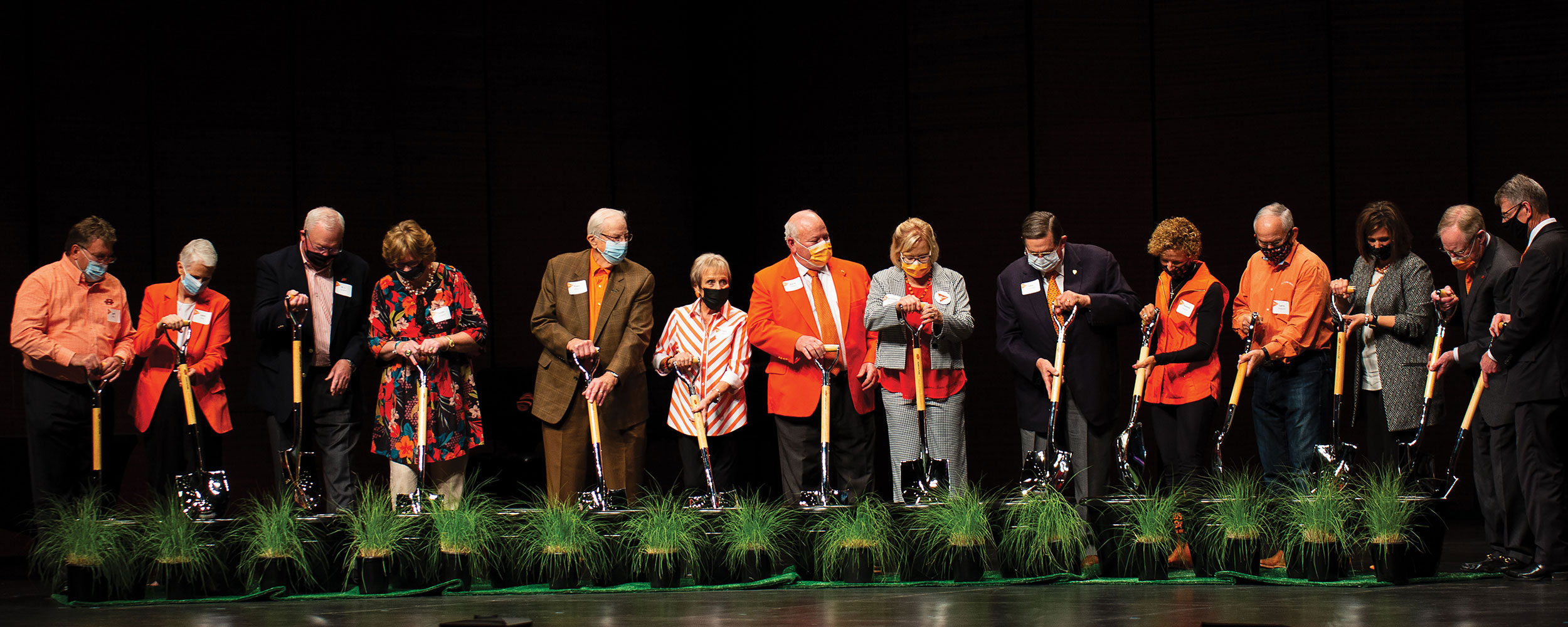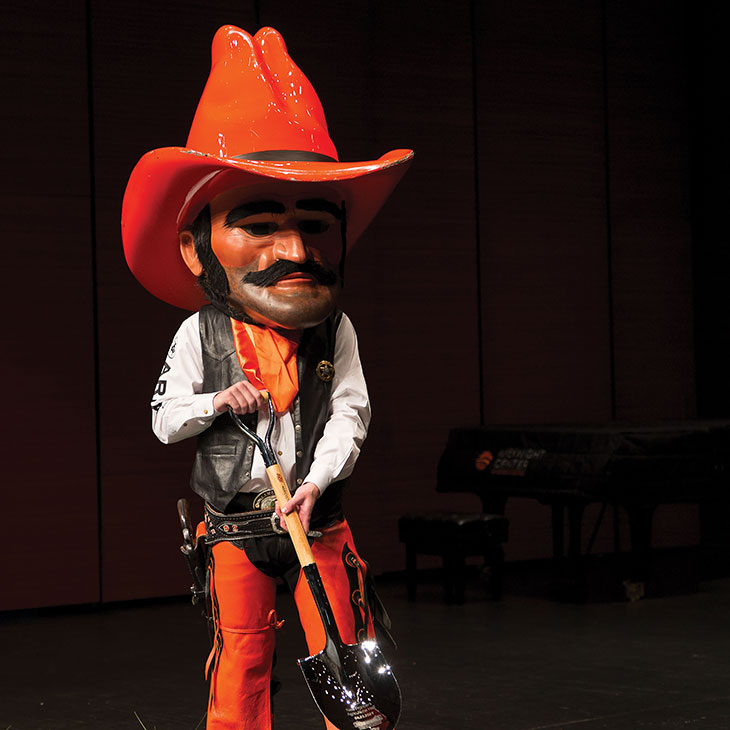
Hallowed Ground
Thursday, June 10, 2021
Media Contact: Samantha Siler | Communications and Marketing Manager | 405-744-2977 | samantha.siler@okstate.edu
Four years after an assessment explored the possibility of the New Frontiers Campaign, ground was broken on the new building for the Ferguson College of Agriculture.
On April 23, 2021, more than 250 guests gathered in The McKnight Center for the Performing Arts to watch donors, administrators and dignitaries launch the next phase of the project by symbolically breaking ground on the new building.
Heidi Williams, senior director of principal gifts at the Oklahoma State University Foundation, said the master planning process assessed many buildings, including Agricultural Hall, and noted the building’s wings were at the end of their serviceable life.
This day was long awaited, starting with the master planning process in 2017, Williams said.
The cost to renovate the existing Agricultural Hall was $90 million, so the focus turned to constructing a new building, Williams said.
“We brought in a consultant early on and asked him to do a feasibility study that was helpful,” said Thomas Coon, vice president and dean of OSU Agriculture. “Then, we took what he found and met with President Burns Hargis to garner his support.
“We went through a series of different decision points,” Coon said. “At one point, after we got the feasibility study back, it didn’t seem clear that we would be able to raise enough money to do the full building.
“However, the Ferguson family’s gift changed our outlook,” he added.
Williams said the total cost of this project is $100 million. Half of the cost will come from private support with the other half coming from the university, she added.

The goal was ‘we need to get to $40 million before we’ll do groundbreaking,’” Williams said.
At the time of the announcement, the campaign was $43 million toward a $50 million goal, Williams added.
Preparations were made for the big day even before the groundbreaking ceremony was underway.
Randy Raper, Division of Agricultural Sciences and Natural Resources director of capital projects, has worked with the architects and faculty regarding the new building.
“The only way I think you make something like a new building be effective and work is if you have complete faculty involvement,” Raper said.
With this project, everyone who understands what is going on and why needs to be involved, Raper said.
“Our faculty have said ‘this is how we think that should look’ and ‘this is how we think it should work,’” Coon said. “That’s the beauty of this project. It’s a lot of people who are contributing to the creative process of having a building and space that’s going to serve our students well long into the future.
“We want to have teaching space that is flexible and adaptable to the way students learn and teachers teach so the faculty members can create the learning environments they want,” Coon added.
One piece of incorporated technology in this building is the teaching lab for agricultural education, Coon said. This lab will allow students studying to be agricultural education teachers to practice their craft, he added.
“They can go in and record themselves teaching a class, and then they can go back and review it with their instructors or with their advisers,” Coon said.
The new building also will change the way faculty conduct research, Coon said.
“Our old model allows every professor to have his or her own laboratory, and that’s where they get their work done,” Coon said. “We want to have large laboratories with multiple investigators in them.”
In the new building, faculty and students will be assigned the amount of laboratory bench space they need, allowing faculty to share expensive equipment as well as communicate and collaborate together, Coon said.
In addition, the new building will have a lot of windows, Raper said.
“As you walk down the hallway, you’re going to be able to look into a research lab and actually see the research going on, which is different than what we have in Agricultural Hall now,” he said.
The natural resource ecology and management department also will see major upgrades, Raper said.
“When NREM was created, it was an assemblage of faculty from across campus, and when they were brought into DASNR, we didn’t really have room for them,” Raper said.
“Essentially, we put them wherever we could find space.”
Because of this, the NREM faculty and labs are dispersed across multiple buildings, he said. The new building will consolidate most of the ecology labs in one area so faculty can work together, he added.
The new building will bring back the Dairy Bar, and the menu for the new restaurant was presented during the groundbreaking event.
“What we heard from the alumni is they really missed the old Dairy Bar,” Coon said.
The old Dairy Bar was located east of Agricultural Hall but was demolished when construction began on what is now the Henry Bellmon Research Center, Coon said.
The Dairy Bar was a place where students and others could get together and drink a glass of milk, have an ice cream, or enjoy a cinnamon roll and coffee, he added.
Something Coon said he really appreciates is the New Frontiers campaign is on schedule.
“Four years ago, we said we want to break ground in the spring of 2021,” Coon said. “And guess what? We did that even though we’ve had a pandemic for the last year.”
The most rewarding part of this project will be seeing people coming and spending time in this building to develop a sense of community, he said.
Coon also wants to see alumni come back and spend time in the building and at the new Dairy Bar, he added.
“We’ve designed a space where people can be creative, whether they’re teaching or learning, conducting research or planning,” Coon said.
“Whatever it is, we want them to find this the most attractive place they can go to get that work done and to be with friends and colleagues.”
Story By: Alicia Young | Cowboy Journal
